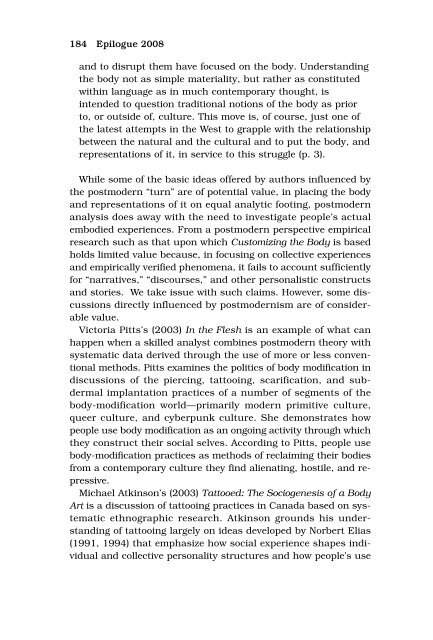Customizing the Body (PDF file) - Print My Tattoo
Customizing the Body (PDF file) - Print My Tattoo
Customizing the Body (PDF file) - Print My Tattoo
You also want an ePaper? Increase the reach of your titles
YUMPU automatically turns print PDFs into web optimized ePapers that Google loves.
184 Epilogue 2008<br />
and to disrupt <strong>the</strong>m have focused on <strong>the</strong> body. Understanding<br />
<strong>the</strong> body not as simple materiality, but ra<strong>the</strong>r as constituted<br />
within language as in much contemporary thought, is<br />
intended to question traditional notions of <strong>the</strong> body as prior<br />
to, or outside of, culture. This move is, of course, just one of<br />
<strong>the</strong> latest attempts in <strong>the</strong> West to grapple with <strong>the</strong> relationship<br />
between <strong>the</strong> natural and <strong>the</strong> cultural and to put <strong>the</strong> body, and<br />
representations of it, in service to this struggle (p. 3).<br />
While some of <strong>the</strong> basic ideas offered by authors influenced by<br />
<strong>the</strong> postmodern “turn” are of potential value, in placing <strong>the</strong> body<br />
and representations of it on equal analytic footing, postmodern<br />
analysis does away with <strong>the</strong> need to investigate people’s actual<br />
embodied experiences. From a postmodern perspective empirical<br />
research such as that upon which <strong>Customizing</strong> <strong>the</strong> <strong>Body</strong> is based<br />
holds limited value because, in focusing on collective experiences<br />
and empirically verified phenomena, it fails to account sufficiently<br />
for “narratives,” “discourses,” and o<strong>the</strong>r personalistic constructs<br />
and stories. We take issue with such claims. However, some discussions<br />
directly influenced by postmodernism are of considerable<br />
value.<br />
Victoria Pitts’s (2003) In <strong>the</strong> Flesh is an example of what can<br />
happen when a skilled analyst combines postmodern <strong>the</strong>ory with<br />
systematic data derived through <strong>the</strong> use of more or less conventional<br />
methods. Pitts examines <strong>the</strong> politics of body modification in<br />
discussions of <strong>the</strong> piercing, tattooing, scarification, and subdermal<br />
implantation practices of a number of segments of <strong>the</strong><br />
body-modification world—primarily modern primitive culture,<br />
queer culture, and cyberpunk culture. She demonstrates how<br />
people use body modification as an ongoing activity through which<br />
<strong>the</strong>y construct <strong>the</strong>ir social selves. According to Pitts, people use<br />
body-modification practices as methods of reclaiming <strong>the</strong>ir bodies<br />
from a contemporary culture <strong>the</strong>y find alienating, hostile, and repressive.<br />
Michael Atkinson’s (2003) <strong>Tattoo</strong>ed: The Sociogenesis of a <strong>Body</strong><br />
Art is a discussion of tattooing practices in Canada based on systematic<br />
ethnographic research. Atkinson grounds his understanding<br />
of tattooing largely on ideas developed by Norbert Elias<br />
(1991, 1994) that emphasize how social experience shapes individual<br />
and collective personality structures and how people’s use



